Enterprise Risk Management Software
Become Risk Led, Not Risk Adverse
Visualize, assess, and manage risks strategically with an integrated, data-driven approach that enhances decision making at every level.
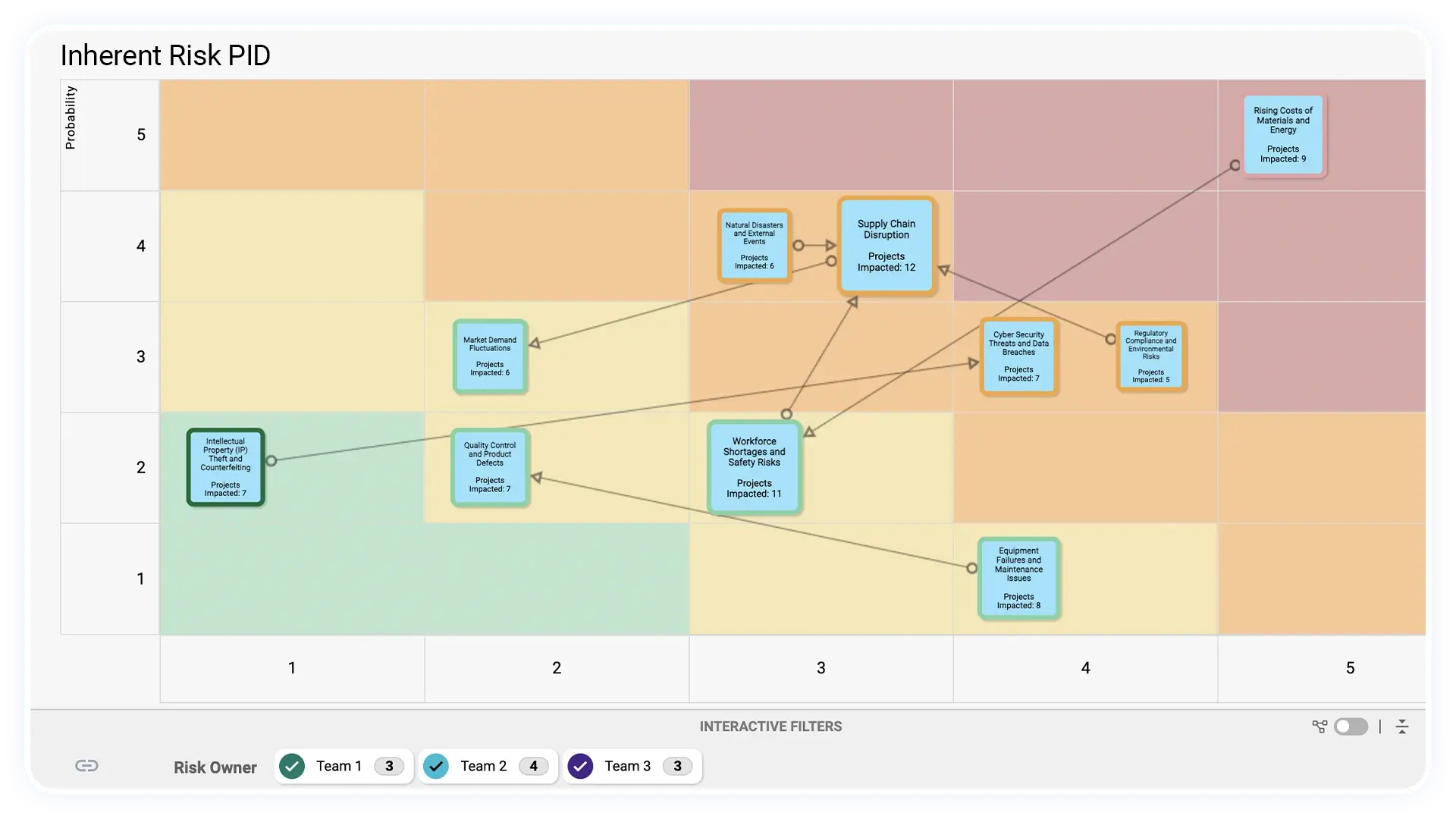
What is Enterprise Risk Management?
Enterprise Risk Management (ERM) is a holistic, organization-wide approach to identifying, assessing, and managing risks that could impact strategic objectives, operations, or performance. Unlike traditional risk management, which focuses on isolated threats, ERM provides a unified view of risks across departments and portfolios - helping leaders understand interdependencies, prioritize responses, and strengthen resilience. By making risk visible and connected to strategy, organizations can make informed decisions that balance opportunity with protection.
Why SharpCloud?
SharpCloud empowers organizations to take a proactive, strategic approach to risk management. Whether you’re a risk manager, executive, or part of a project team, SharpCloud's enterprise risk management software helps you move beyond static risk registers to a connected, interactive platform. With dynamic, data-driven risk mapping, you can identify potential risks and threats, evaluate their impact, and prioritize mitigation in alignment with strategic goals. Evolve your approach from basic tracking to advanced methodologies like Risk BowTie for smarter decision-making.

Connected risks
Traditional risk registers store information but fail to reveal critical relationships between risks. SharpCloud connects risks across your organization, helping you identify dependencies, cascading impacts, and hidden vulnerabilities. By visualizing these connections, you gain a deeper understanding of how risks influence each other, enabling proactive mitigation and more strategic decision-making.

A clear view from above
SharpCloud gives you a high-level, connected view of all risks across your organization, making it easy to spot patterns, prioritize threats, and align mitigation efforts with strategic goals. Instead of siloed data, you get an interactive, visual risk landscape with real time data that helps leadership focus on what matters most and drive smarter, faster decisions.

Risk beyond the risk team
SharpCloud connects risks to business goals, shifting conversations from risk avoidance to strategic proactive risk management. By linking risks to key drivers and objectives, senior leaders gain a clear understanding of their potential impacts, enabling proactive decision-making that balances risk with opportunity across the entire organization.
Integrated Risk Management Software Key Features
Connected Landscape
Connect risks to each other, controls, consequences, and business objectives to see how one risk can impact the entire landscape. Uncover dependencies, prevent cascading threats, and take proactive action with a holistic, real-time view.
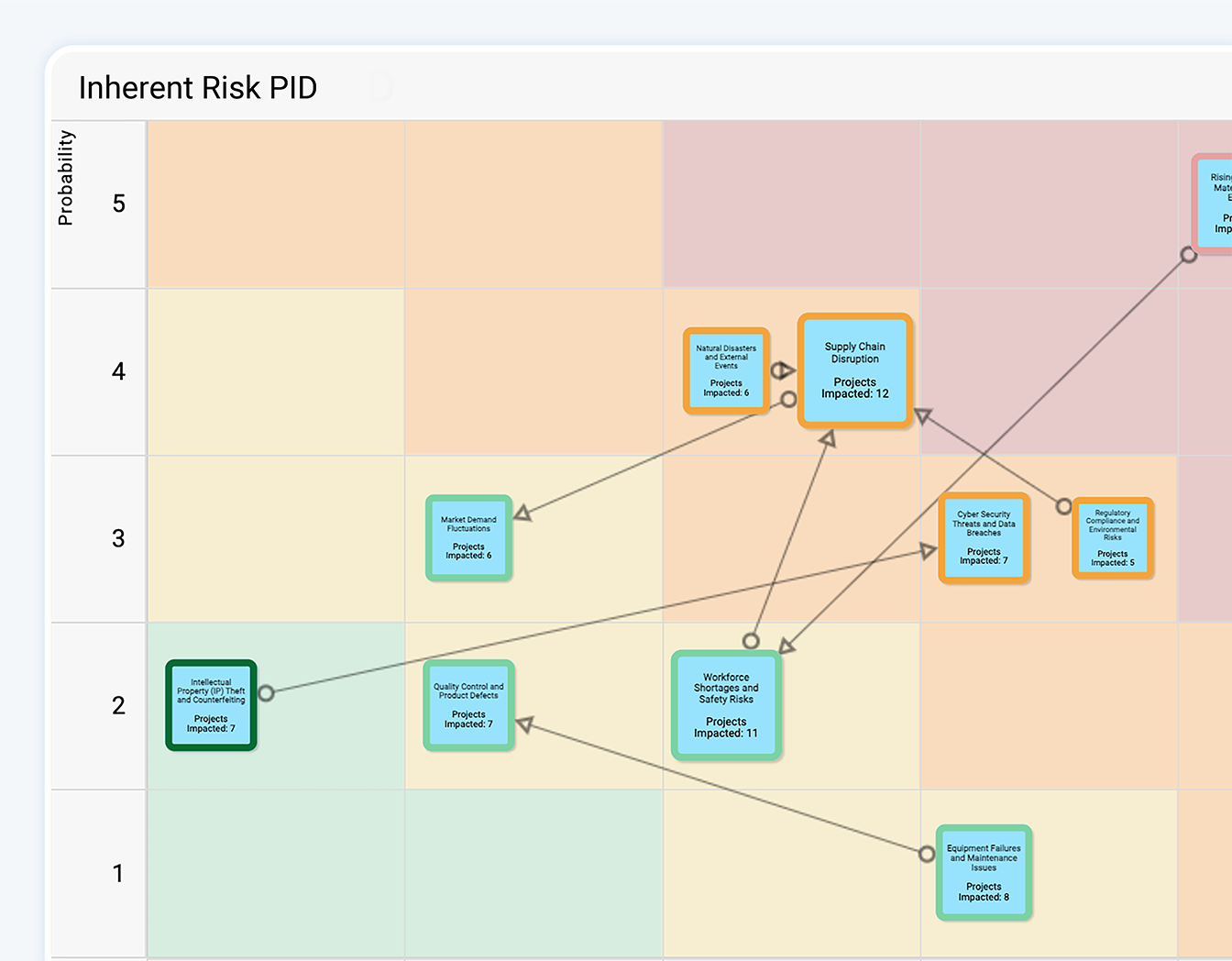
Gain New Insight
Focus on key information while retaining context across flexible visualizations. Cut through the noise to reveal new insights, patterns, and hidden risks that drive smarter decision-making.
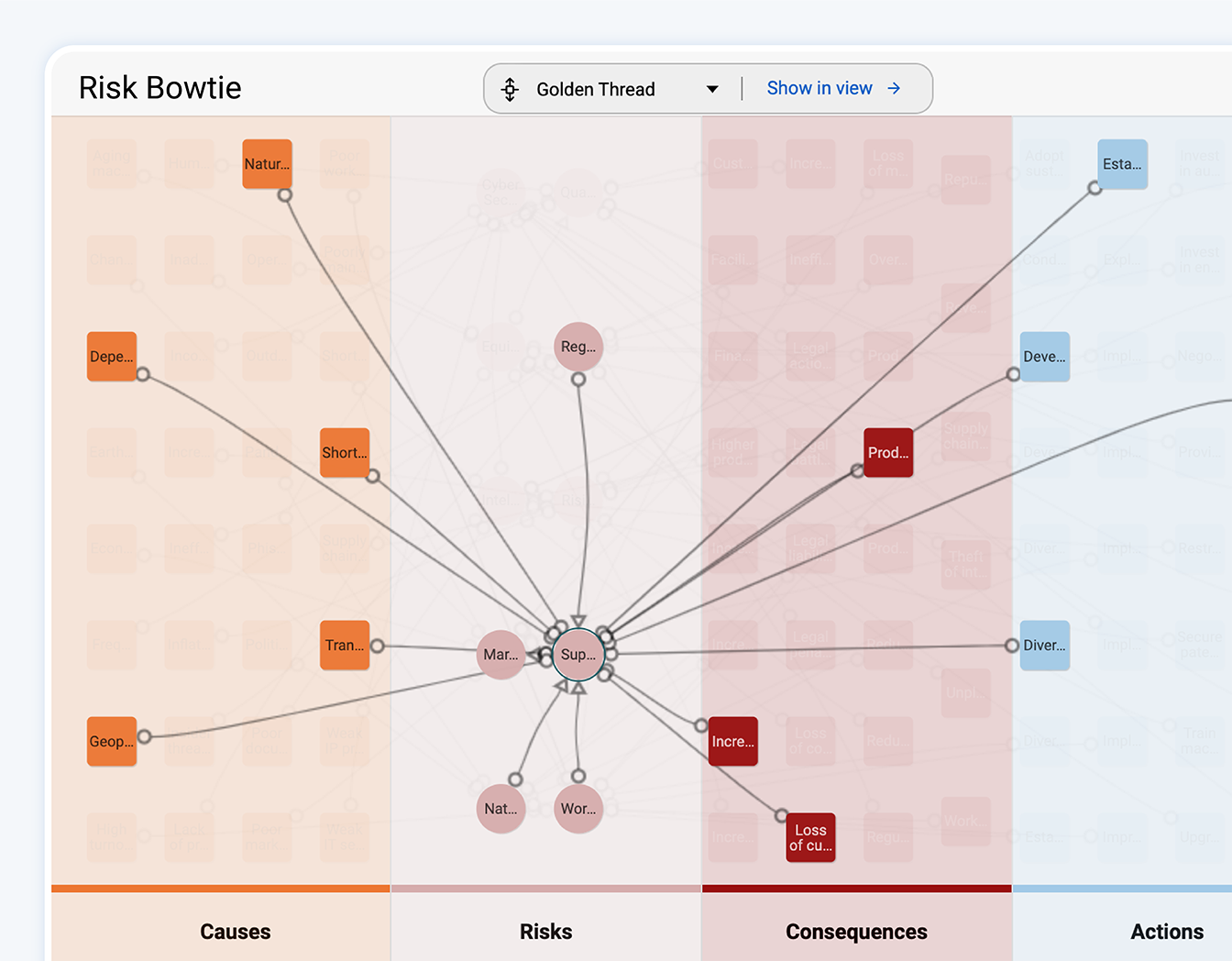
Linked to the Business
Align identified risks with strategic objectives, projects, and operations to see the full business impact. Ensure your risk management framework is integrated, not siloed, for better decision-making and resilience.
.webp)
Deep Dive into Detail
No more overloaded PowerPoints - store all your risk data in one place. Organize documents, diagrams, links, and more, keeping everything easily accessible and structured.
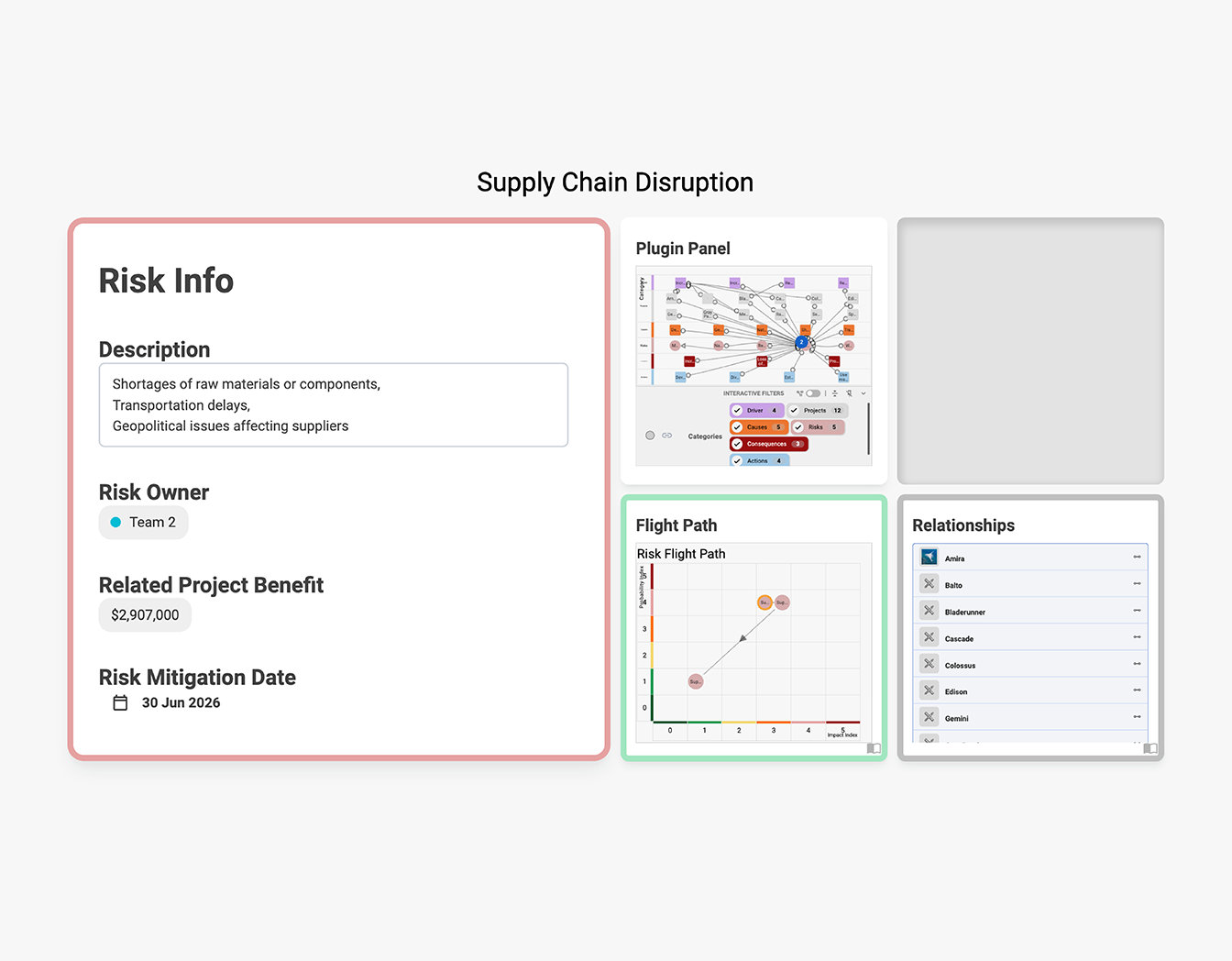
Integrate with Existing Tools
Already have your data in another risk management tool? No problem! Simply connect to your preferred platform and maximize its value with SharpCloud.
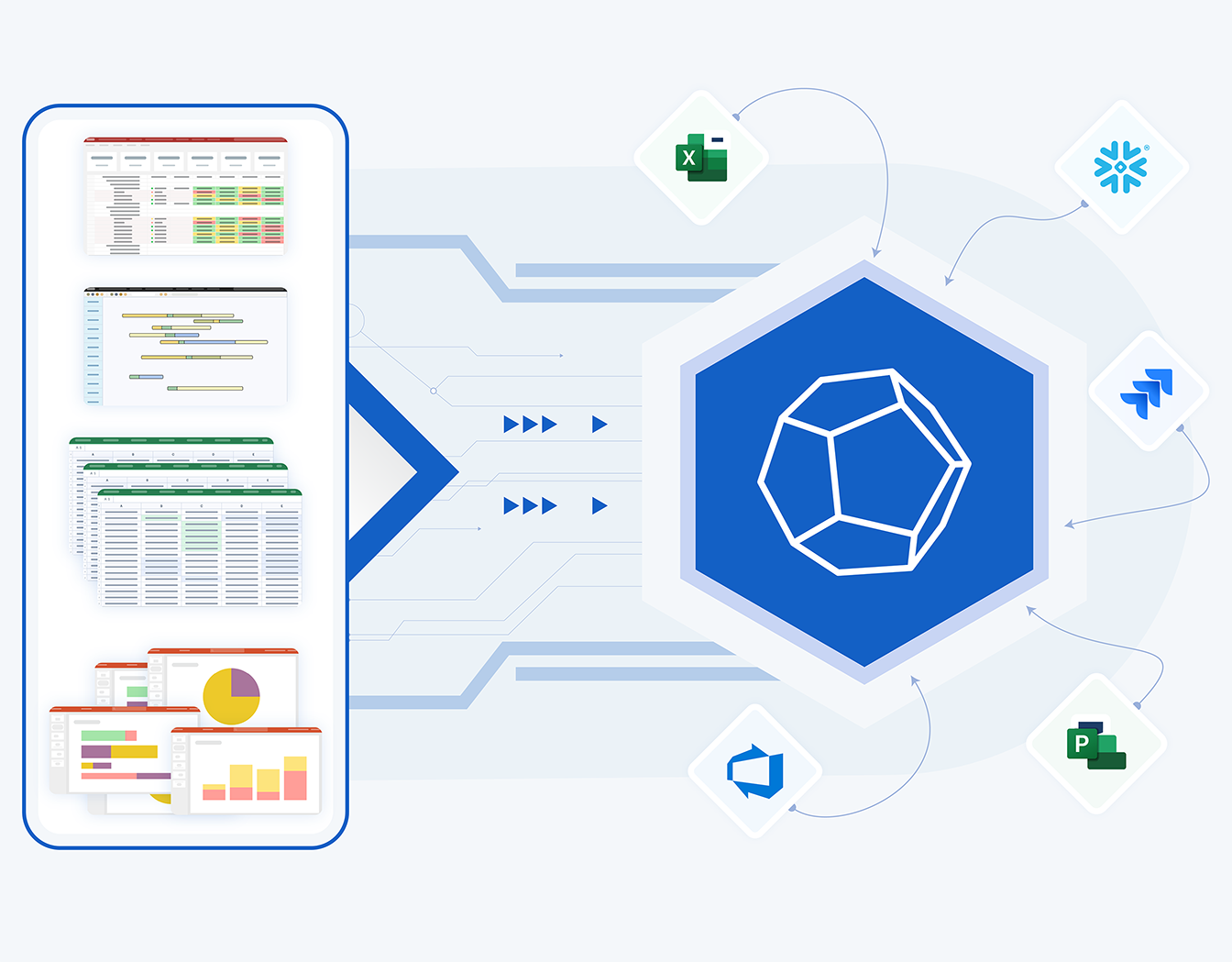


.webp)


“SharpCloud has revolutionized risk conversations by simplifying a complex and interrelated dataset, with easy to understand visuals customizable to different levels in the organization. Getting senior leadership attention and enabling the organization to understand and manage the risks of achieving our objectives; for me SharpCloud is priceless.”
Hear from our valued users

At Rolls-Royce, managing security and resilience is no small task. With 400+ sites and a complex organizational structure, bringing together critical risk data, aligning priorities, and making informed decisions is a constant challenge.

As a Risk Management SME, David Shipp has seen first-hand how missed dependencies can cost organizations millions. Managing risk isn’t just about tracking issue - it’s about connecting people, data, and decisions in real-time.
Want to see how SharpCloud's risk management tool can help you?
Our demo covers:
- The progression from a basic risk register to advanced risk management with SharpCloud.
- How SharpCloud connects risks to each other and other key areas of your business.
- Real-world examples from customers using SharpCloud for an effective risk management process.
- Insights into the typical journey our risk users take and the timeline for each stage.
“It's fair to say that before SharpCloud, it was really difficult to keep momentum on action tracking, progress updates, and closures. It has been transformational in showing information in this way to multiple risk control and action owners.”
Sue Nugent | Risk, BCM & Insurance Manager
If your team uses it, we integrate with it
SharpCloud seamlessly integrates with existing data sources via Data Connectors, ensuring smooth data flow without heavy IT overhead.
It works alongside tools like Excel, REST and SQL, providing powerful risk analysis and visualization without requiring a full system overhaul. By eliminating duplicate manual entry, SharpCloud saves time and makes the most out of the data you already have.
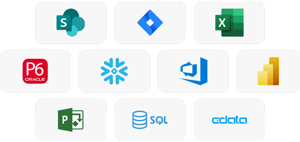
Resources

An effective enterprise risk management method, if integrated properly, can result in substantial cost savings for the company.
Read More
Devon & Somerset Fire and Rescue used SharpCloud to achieve a greater visibility of risks, controls, and impacts and improve tracking of actions, progress updates and closures.
Read More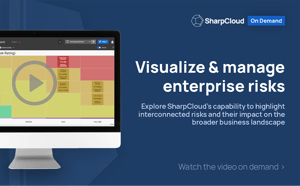
Visualize, manage, and understand your risks and see how they connect to or impact the rest of your business. Get the clarity you need across a complex business landscape.
Read MoreYour data is safe with us
We offer flexible hosting options to meet a wide range of security and compliance requirements. SharpCloud also comes with Role-Based Access Control, giving you precise control over what data users can view or edit at a granular level.
FAQ's
Enterprise Risk Management (ERM) software is a tool designed to help organizations identify, assess, monitor, and mitigate risks across their entire business ecosystem. It provides a systematic approach to managing risks, from strategic and operational risks to financial and compliance risks. The goal of ERM software is to ensure that risks are managed proactively to minimize negative impacts and seize potential opportunities.
Key features of ERM software typically include:
-
Risk Identification: Tools such as a risk register to identify potential risks across various business areas, including financial, operational, strategic, and compliance-related risks.
-
Risk Assessment: Capabilities to assess the likelihood and potential impact of identified risks, helping prioritize them based on severity and relevance to the organization’s objectives.
-
Risk Mitigation and Control: Features for developing strategies and action plans to mitigate identified risks, track risk responses, and implement controls to reduce risk exposure.
-
Real-time Monitoring and Reporting: Dashboards and visualizations that provide real-time monitoring of risk indicators, enabling timely updates and responses to emerging threats.
-
Collaboration and Integration: Tools that facilitate collaboration across departments, breaking down silos to ensure a unified and organization-wide approach to risk management. ERM software often integrates with other enterprise systems like ERP and CRM to provide a holistic view.
-
Governance Risk and Compliance: Capabilities to track and manage compliance with regulations and standards (such as ISO, Sarbanes-Oxley, GDPR), ensuring that risk management efforts align with legal requirements.
-
Data-Driven Insights: Using analytics and data modeling to help predict future risks, optimize risk mitigation strategies, and align with business goals.
-
Audit Trails and Documentation: ERM software often includes audit trails for documenting assessment risk decisions and actions, which is important for regulatory compliance and internal accountability.
The four key pillars of Enterprise Risk Management (ERM) are:
-
Risk identification – Recognizing and categorizing potential risks that could impact the organization, including operational, strategic, financial, compliance, and cybersecurity risks.
-
Risk assessment & analysis – Evaluating the likelihood and potential impact of identified risks, often using qualitative and quantitative methods to prioritize threats.
-
Risk mitigation & response – Developing and implementing strategies to minimize, transfer, accept, or eliminate risks. This includes internal controls, contingency plans, and risk transfer mechanisms like insurance.
-
Risk monitoring & reporting – Continuously tracking risks, assessing the effectiveness of mitigation efforts, and providing regular reports to leadership to ensure informed decision-making and regulatory compliance.
Future trends in Enterprise Risk Management (ERM) software are evolving to keep pace with increasingly complex business environments and emerging risks. Here are some key developments to watch:
1. AI & predictive analytics
ERM software will leverage AI and machine learning to enhance risk detection and forecasting. These technologies will analyze vast datasets to identify emerging threats, predict potential risks, and recommend mitigation strategies in real time.
2. Real-time risk monitoring
Rather than relying on periodic assessments, future ERM solutions will offer continuous risk tracking. This ensures organizations can detect and respond to risks as they arise, minimizing potential disruptions.
3. Integration with business systems
ERM platforms will become more interconnected with ERP, CRM, and project management systems, embedding risk considerations directly into decision-making processes.
4. Cloud-based & scalable solutions
Cloud-based ERM platforms will continue to grow, offering organizations scalability, cost-effectiveness, and seamless data integration across multiple systems and locations.
5. Enhanced visualization & dashboards
Dynamic, interactive dashboards will make risk insights more accessible, enabling executives to quickly understand dependencies, vulnerabilities, and priorities.
6. Automated compliance & reporting
Regulatory requirements are becoming more complex, and ERM software will increasingly feature automated compliance tracking and reporting to help organizations stay ahead of evolving regulations.
7. Cybersecurity & third-party Risk Management
As cyber threats rise, ERM software will place greater emphasis on cyber risk management, including third-party risk assessments to protect against supply chain vulnerabilities.
8. Customizable risk scenarios & stress testing
Organizations will be able to run "what-if" simulations to assess the impact of potential risks under different conditions, helping them prepare for disruptions more effectively.
9. Increased focus on ESG & sustainability risks
ERM will expand to include environmental, social, and governance (ESG) risks, ensuring businesses account for sustainability, climate-related risks, and regulatory changes.
10. Greater cross-functional collaboration
ERM solutions will encourage broader team involvement, breaking down silos and ensuring that risk management is an organization-wide effort, rather than just a compliance function.
SharpCloud offers seamless integration with other systems through Data Connectors, including native connections to tools like Excel, REST, SQL, and more. In partnership with CData, we provide access to over 250+ additional connectors, enabling broader system connectivity. Additionally, our APIs allow you to create, update, and delete data in a story, providing flexibility in managing your risk data across multiple platforms.
The timeline for getting started with SharpCloud can vary based on your needs, but we work closely with you to tailor the process for your organization.
If your data is ready, you can begin visualizing and uncovering insights within hours. For a more comprehensive setup, including stakeholder input, custom views, and training, we typically run a 1-month Proof of Value. During this period, we refine visualizations through iterative feedback, ensuring they address key questions and empower you to be self-sufficient in SharpCloud. While the setup speed depends on collaboration and available resources, most users see meaningful results quickly.
Key stages to get started:
-
Visualizing your risks: Quick setup based on available data
-
Connecting your risks: Align risks with other relevant business elements
-
Automating processes: Streamline workflows and reduce manual effort
-
Advancing the register: Enhance your risk register and management capabilities
Not necessarily. We can create data within the platform itself to give you an idea of what is achievable. If you have some data, that's even better - it helps you relate to the insights more effectively, but no data is perfect! One of the key benefits of visualizing your data is uncovering gaps, trends, and inconsistencies, helping you refine and move forward with confidence.
Yes, we have 3 subscription types - Creator, Collaborator and Read-Only subscriptions. Creators can do everything, build and maintain stories and configure data connectors and so on. Collaborators help keep the data up to date and Read-only users can view, interact and comment on the story. More info can be found on our pricing page.
Absolutely. In SharpCloud, we have Role Based Access, so you can design roles for users and determine what data they can edit or see.
Your data can be hosted in Microsoft Azure Data Centers across the UK, US, or EU, as well as other regions if needed. SharpCloud is also available on the UK and US Government Cloud for added security. If you prefer, you can host SharpCloud on-premises or on your chosen cloud platform, with support for both Windows and Linux/Docker environments.
.png?width=200&height=137&name=ClientLogo_MinistryOfDefence%20(product).png)
.png?width=200&height=117&name=ClientLogo_Amcor%20(product).png)
.png?width=200&height=117&name=ClientLogo_ThermoFisher%20(product).png)
test.png?width=200&height=117&name=ClientLogo_GeneralDynamics%20(product)test.png)
.webp?width=200&height=117&name=ClientLogo_UltraPrecision-Short%20(product).webp)
-1.png?width=200&height=117&name=ClientLogo_Ofwat%20(product)-1.png)
.png?width=200&height=117&name=ClientLogo_NetworkRail%20(product).png)


.webp?width=200&height=117&name=ClientLogo_Enetris%20(product).webp)
.png?width=204&height=92&name=ClientLogo_DevonSommerstFireRescue%20(Quote).png)